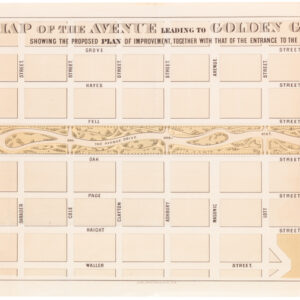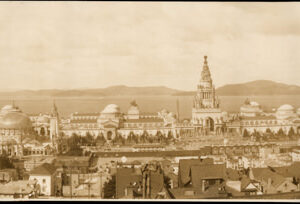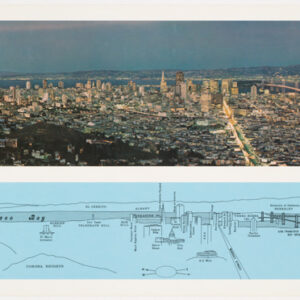Attractive chart of the Bay Area with detailed mapping of San Francisco, the East Bay, and Marin County.
San Francisco Entrance
Out of stock
Description
Ostensibly a sea chart, this handsome U.S. Coast and Geodetic Survey separate-issue offers an incredible array of cartographic information, not just coastal, but inland topography and city and town plans as well.
Published during World War II, important maritime data fills the chart, from shipping lanes, tides, and depth soundings, to lighthouses, buoys, and diaphones (a low-pitched fog signal operated by compressed air). Different anchorage classifications are listed and mapped, including: naval anchorages, quarantine anchorages reserved by the U.S. Public Health Service, and anchorages with wide forbidden zones reserved for vessels with explosives.
As for land, the map presents three main areas: the San Francisco peninsula south to Colma, the East Bay including Alameda, Oakland, Berkeley, and Richmond, and the North Bay from Sausalito to San Rafael.
The topographic detail in Marin County is especially astounding, with intricate topographic lines giving shape to Mt. Tamalpais and the coastal rises at Stinson Beach and Bolinas Bay. The marsh lands at Corte Madera and San Rafael Creeks are nicely delineated and the shape of the Marin towns are easily seen. The age of the automobile has arrived with the opening of the Golden Gate Bridge in May 1937, but we still see the tracks of the Northwest Pacific Railroad running from Sausalito to Mill Valley and then north. The N.W.P.R.R would close these down the following year.
In the East Bay, we see the continuing development of Alameda, with one area in the bay marked “Being dredged,” as well as its growing importance as a military center, with a Naval Air Station under construction.
San Francisco itself is intricately mapped, with building detail and topography.
Cartographer(s):
The Office of Coast Survey is the official chartmaker of the United States. Set up in 1807, it is one of the U.S. government’s oldest scientific organizations. In 1878 it was given the name of Coast and Geodetic Survey (C&GS). In 1970 it became part of the National Oceanic and Atmospheric Administration (NOAA).
The agency was established in 1807 when President Thomas Jefferson signed the document entitled “An act to provide for surveying the coasts of the United States.” While the bill’s objective was specific—to produce nautical charts—it reflected larger issues of concern to the new nation: national boundaries, commerce, and defense.
Alexander Dallas Bache, great-grandson of Benjamin Franklin, was the second Coast Survey superintendent. Bache was a physicist, scientist, and surveyor who established the first magnetic observatory and served as the first president of the National Academy of Sciences. Under Bache, Coast Survey quickly applied its resources to the Union cause during the Civil War. In addition to setting up additional lithographic presses to produce the thousands of charts required by the Navy and other vessels, Bache made a critical decision to send Coast Survey parties to work with blockading squadrons and armies in the field, producing hundreds of maps and charts.
In 1871, Congress officially expanded the Coast Survey’s responsibilities to include geodetic surveys in the interior of the country, and one of its first major projects in the interior was to survey the 39th Parallel across the entire country. Between 1874 and 1877, the Coast Survey employed the naturalist and author John Muir as a guide and artist during the survey of the 39th Parallel in the Great Basin of Nevada and Utah. To reflect its acquisition of the mission of surveying the U.S. interior and the growing role of geodesy in its operations, the U.S. Coast Survey was renamed the United States Coast and Geodetic Survey (USC&GS) in 1878.
Condition Description
Folds in 4, with some wear and creasing.
References



![Inside [San Francisco]](https://neatlinemaps.com/wp-content/uploads/2019/11/NL-00737-scaled-300x300.jpg)